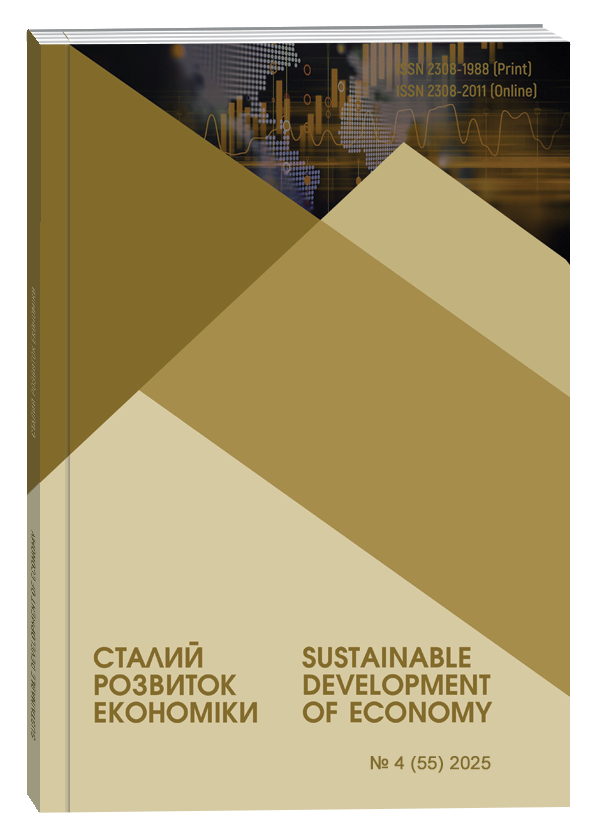ЕКОЛОГІЗАЦІЯ ПРОМИСЛОВОСТІ ВІДПОВІДНО ДО ІНДИКАТИВНОЇ РАМКИ ЦИРКУЛЯРНОЇ ЕКОНОМІКИ ЄС
Анотація
У статті здійснено аналіз індикативної рамки циркулярної економіки ЄС як орієнтиру екологізації промисловості. Обґрунтовано, що структура зелених ініціатив промислових підприємств є диференційованою за напрямами, зокрема домінують практики мінімізації відходів, енергозбереження та раціонального використання матеріалів. Проведено системний аналіз п’яти блоків індикативної рамки. Узагальнено як позитивні результати (розвиток екодизайну, підвищення переробки, інноваційна активність), так і проблемні аспекти (матеріалоємність виробництва, залежність від імпорту критичних ресурсів, недостатність цифрових індикаторів). Сформовано стратегічні пріоритети екологізації, що охоплюють оптимізацію матеріальних потоків, розвиток замкнених циклів управління відходами, використання вторинної сировини, посилення інноваційного та цифрового лідерства, а також забезпечення глобальної стійкості.
Посилання
München: Fraunhofer Institute for Systems and Innovation Research ISI, 2025. 223 p. DOI: https://doi.org/10.24406/publica-3953
Krysovatyy A., Maksymova I., Kurilyak V., Radin M., Kurilyak M. International convergence towards a climate-neutral economy: modeling the agricultural sector. Agricultural and Resource Economics: International Scientific E-Journal. 2024. Vol. 10. № 2. P. 52–79. DOI: https://doi.org/10.51599/are.2024.10.02.03
The CO2NSTRUCT European project: Modelling the role of Circular Economy in construction value chains for a carbon-neutral Europe / Oikonomou T. I. et al. IOP Conference Series: Earth and Environmental Science, 2023. Vol. 1196. No. (1). DOI: https://doi.org/10.1088/1755-1315/1196/1/012043
Möslinger M., Ulpiani G., Vetters N. Circular economy and waste management to empower a climate-neutral urban future. Journal of Cleaner Production. 2023. Vol. 421. DOI: https://doi.org/10.1016/j.jclepro.2023.138454
Strategic foresight report 2023 / edited by EU publication office. EU, 2023. 58 p. DOI: https://doi.org/10.2792/32296
Maksymova I., Nastase C. European model of climate-neutral business development based on digitalization principles. Journal of European Economy. 2024. Vol. 23. №. 2. P. 336-352. DOI: https://doi.org/10.35774/jee2024.02.336
Todaro D. L., Torelli R. From greenwashing to ESG‐washing: A focus on the circular economy field. Corporate Social Responsibility and Environmental Management. 2024. Т. 31. №. 5. P. 4034-4046. DOI: https://doi.org/10.1002/csr.2786
Bibby D. Global focus on ESG in the supply chain–insights into supply chain management of Environmental, Social and Governance requirements and trends both locally and globally. Australian Energy Producers Journal. 2024. Т. 64. №. 2. Р. S468-S471. DOI: https://doi.org/10.1071/EP23100
Hushko S., Bai O. EU Metrics for the Circular Economy in Light of Modern Business Practices. Economics and technical engineering. 2025. Т. 3. №. 1. Р. 8-20. DOI: https://doi.org/10.62911/ete.2025.03.01.01
Shavkatov N. et al. Circular economy practices and their effect on corporate financial performance. Economic Annals-XXI, 2024. Vol. 207 (1-2). P. 4-9. DOI: https://doi.org/10.21003/ea.V207-01
Circular pathways to sustainable development: understanding the links between circular economy indicators, economic growth, social well-being, and environmental performance in EU-27 / Arion F. H. et al. Sustainability, 2023. Т. 15. №. 24.. DOI: https://doi.org/10.3390/su152416883
Tan J., Tan F. J., Ramakrishna S. Transitioning to a circular economy: A systematic review of its drivers and barriers. Sustainability, 2022. Т. 14. №. 3. DOI: https://doi.org/10.3390/su14031757
Alivojvodic V., Kokalj F. Drivers and barriers for the adoption of circular economy principles towards efficient resource utilisation. Sustainability, 2024. Т. 16. №. 3. DOI: https://doi.org/10.3390/su16031317
Towards circular economy indicators: Evidence from the European Union / D’Adamo I. et al. Waste Management & Research, 2024. Т. 42. №. 8. P. 670-680. DOI: https://doi.org/10.1177/0734242X241237171
Innovation In The Energy Sector: The Transition To Renewable Sources As A Strategic Step Towards Sustainable Development / Lukashevych Y. et al. African Journal of Applied Research. 2024. Vol. 10. №. 1. С. 43-56. DOI: https://doi.org/10.26437/ajar.v10i1.665
Sustainable Behaviour Management in the Strategic Development of Circular Economy Businesses / Koval V. et al. International Journal of Mathematical, Engineering & Management Sciences. 2025. Т. 10. №. 1. P. 113-128. DOI: https://doi.org/10.33889/IJMEMS.2025.10.1.007
Sabău-Popa, C. D., Bele, A. M., Dodescu, A. O., & Boloș, M. I. How Does the Circular Economy Applied in the European Union Support Sustainable Economic Development?. Sustainability, 2022. No. 14(16). DOI: https://doi.org/10.3390/su14169932
National circular economy policies among the EU Member States. European Environment Agency, 2023. URL: https://www.eea.europa.eu
Financing SMEs for sustainability: Drivers, Constraints and Policies, OECD SME and Entrepreneurship Papers, No. 35, OECD Publishing, Paris, 2022. DOI: https://doi.org/10.1787/a5e94d92-en
Circular economy – overview and indicators. Eurostat, 2024. URL: https://ec.europa.eu/eurostat/web/circular-economy/overview
Circular economy in action: Examining the decoupling of economic growth and material use across EU countries / Huttmanová E. et al. European Journal of Sustainable Development. 2024. Т. 13. №. 4. P. 13-13. DOI: https://doi.org/10.14207/ejsd.2024.v13n4p13
Accelerating the circular economy in Europe. European Environment Agency, 2024. Report No. 13/2023. URL: https://www.eea.europa.eu/en/analysis/publications/accelerating-the-circular-economy
Suchowska-Kisielewicz M., Jędrczak A. Impact of Implementing Circular Waste Management System and Energy Recovery in a City with 100,000 Inhabitants on Nitrogen Emissions by 2035. Energies. 2023. Т. 17. №. 1. P. 108. DOI: https://doi.org/10.3390/en17010108
Gulley A. L. The development of China’s monopoly over cobalt battery materials. Mineral Economics. 2024. Т. 37. №. 3. С. 619-631. DOI: https://doi.org/10.1007/s13563-024-00447-w
Lotz, M. T. (2025). Circular economy for the decarbonisation of basic materials. Fraunhofer ISI. 223 p. DOI: https://doi.org/10.24406/publica-3953
Krysovatyy, A., Maksymova, I., Kurilyak, V., Radin, M., & Kurilyak, M. (2024). International convergence towards a climate-neutral economy: modeling the agricultural sector. Agricultural and Resource Economics: International Scientific E-Journal, no. 10, is. 2, pp. 52–79. DOI: https://doi.org/10.51599/are.2024.10.02.03
Oikonomou, T. I., Karytsas, S., Simões, S., Calvo, O. S., Zerbino, PP., & Genovese, A. (2023). The CO2NSTRUCT European project: Modelling the role of Circular Economy in construction value chains for a carbon-neutral Europe. IOP Conference Series: Earth and Environmental Science, no. 1196, is. 1, pp. 1-11. DOI: https://doi.org/10.1088/1755-1315/1196/1/012043
Möslinger, M., Ulpiani, G., & Vetters, N. (2023). Circular economy and waste management to empower a climate-neutral urban future. Journal of Cleaner Production, no. 421. DOI: https://doi.org/10.1016/j.jclepro.2023.138454
EU publication office (2023), Strategic foresight report 2023, EU. 58 p. DOI: https://doi.org/10.2792/32296
Maksymova, I., & Nastase, C. (2024). European model of climate-neutral business development based on digitalization principles. Journal of European Economy, vol. 23, is. 2, pp. 336-352. DOI: https://doi.org/10.35774/jee2024.02.336
Todaro, D. L., & Torelli, R. (2024). From greenwashing to ESG‐washing: A focus on the circular economy field. Corporate Social Responsibility and Environmental Management, no. 31, is. 5, pp. 4034-4046. DOI: https://doi.org/10.1002/csr.2786
Bibby, D. (2024). Global focus on ESG in the supply chain–insights into supply chain management of Environmental, Social and Governance requirements and trends both locally and globally. Australian Energy Producers Journal, no. 64, is. 2, pp. 468-471. DOI: https://doi.org/10.1071/EP23100
Hushko, S., & Bai, O. (2025). EU Metrics for the Circular Economy in Light of Modern Business Practices. Economics and technical engineering, no. 3, is. 1, pp. 8-20. DOI: https://doi.org/10.62911/ete.2025.03.01.01
Shavkatov, N., Abdurakhimova, D., Sherkuziyeva, N., Omonov, S., & Rakhmedova, M. (2024). Circular economy practices and their effect on corporate financial performance. Economic Annals-XXI, vol. 207, pp. 4-9. DOI: https://doi.org/10.21003/ea.V207-01
Arion, F. H., Aleksanyan, V., Markosyan, D., & Arion, I. D. (2023). Circular pathways to sustainable development: understanding the links between circular economy indicators, economic growth, social well-being, and environmental performance in EU-27. Sustainability, no. 15, is. 24, pp. 16883-16898. DOI: https://doi.org/10.3390/su152416883
Tan, J., Tan, F. J., & Ramakrishna, S. (2022). Transitioning to a circular economy: A systematic review of its drivers and barriers. Sustainability, no. 14, is. 3, pp. 1757. DOI: https://doi.org/10.3390/su14031757
Alivojvodic, V., & Kokalj, F. (2024). Drivers and barriers for the adoption of circular economy principles towards efficient resource utilisation. Sustainability, no. 16, is. 3, pp. 1317. DOI: https://doi.org/10.3390/su16031317
D’Adamo, I., Favari, D., Gastaldi, M., & Kirchherr, J. (2024). Towards circular economy indicators: Evidence from the European Union. Waste Management & Research, no. 42, is. 8, pp. 670-680. DOI: https://doi.org/10.1177/0734242X241237171
Lukashevych, Y., Evdokimov, V., Polukhin, A., Maksymova, I., & Tsvilii, D. (2024). Innovation in the energy sector: The transition to renewable sources as a strategic step towards sustainable development. African Journal of Applied Research, no. 10, is. 1, pp. 43-56. DOI: https://doi.org/10.26437/ajar.v10i1.665
Koval, V., Kichuk, Y., Kornieieva, T., Metil, T., Udovychenko, V., & Soloviova, O. (2025). Sustainable Behaviour Management in the Strategic Development of Circular Economy Businesses. International Journal of Mathematical, Engineering & Management Sciences, no. 10, is. 1, pp. 113-128. DOI: https://doi.org/10.33889/IJMEMS.2025.10.1.007
Sabău-Popa, C. D., Bele, A. M., Dodescu, A. O., & Boloș, M. I. (2022). How Does the Circular Economy Applied in the European Union Support Sustainable Economic Development? Sustainability, no. 14, is. 16. DOI: https://doi.org/10.3390/su14169932
European Environment Agency. (2023). National circular economy policies among the EU Member States. Available at: https://www.eea.europa.eu
OECD (2022). Financing SMEs for sustainability: Drivers, Constraints and Policies, OECD SME and Entrepreneurship Papers, no. 35, OECD Publishing, Paris. DOI: https://doi.org/10.1787/a5e94d92-en
Eurostat. (2024). Circular economy – overview and indicators. Available at: https://ec.europa.eu/eurostat/web/circular-economy/overview
Huttmanová, E., Chovancová, J., Petruška, I., & Sallaku, K. (2024). Circular economy in action: Examining the decoupling of economic growth and material use across EU countries. European Journal of Sustainable Development, no. 13, is. 4, pp. 13-13. DOI: https://doi.org/10.14207/ejsd.2024.v13n4p13
European Environment Agency. (2024). Accelerating the circular economy in Europe (EEA Report No. 13/2023). Available at: https://www.eea.europa.eu/en/analysis/publications/accelerating-the-circular-economy
Suchowska-Kisielewicz, M., & Jędrczak, A. (2023). Impact of Implementing Circular Waste Management System and Energy Recovery in a City with 100,000 Inhabitants on Nitrogen Emissions by 2035. Energies, vol. 17, is. 1, pp. 108. DOI: https://doi.org/10.3390/en17010108
Gulley, A. L. (2024). The development of China’s monopoly over cobalt battery materials. Mineral Economics, no. 37, is. 3, pp. 619-631. DOI: https://doi.org/10.1007/s13563-024-00447-w


